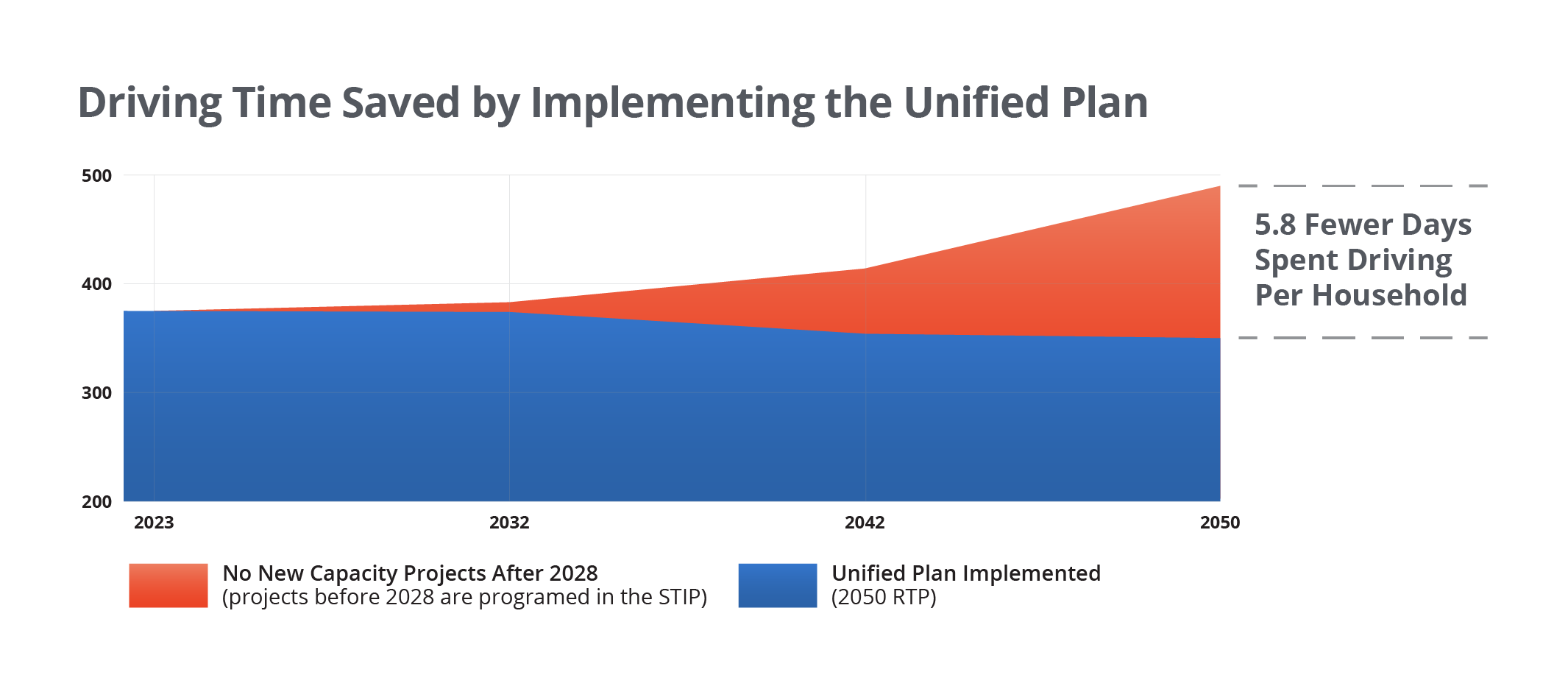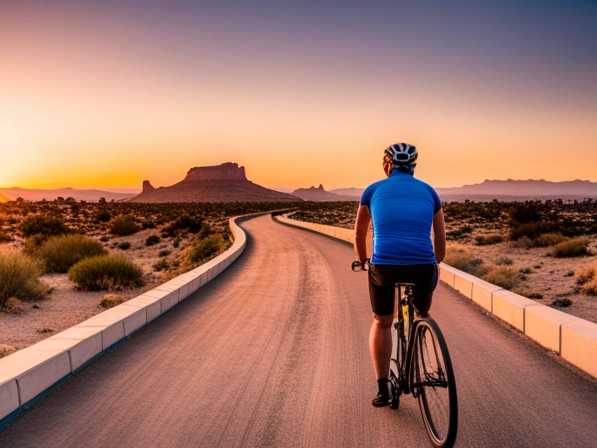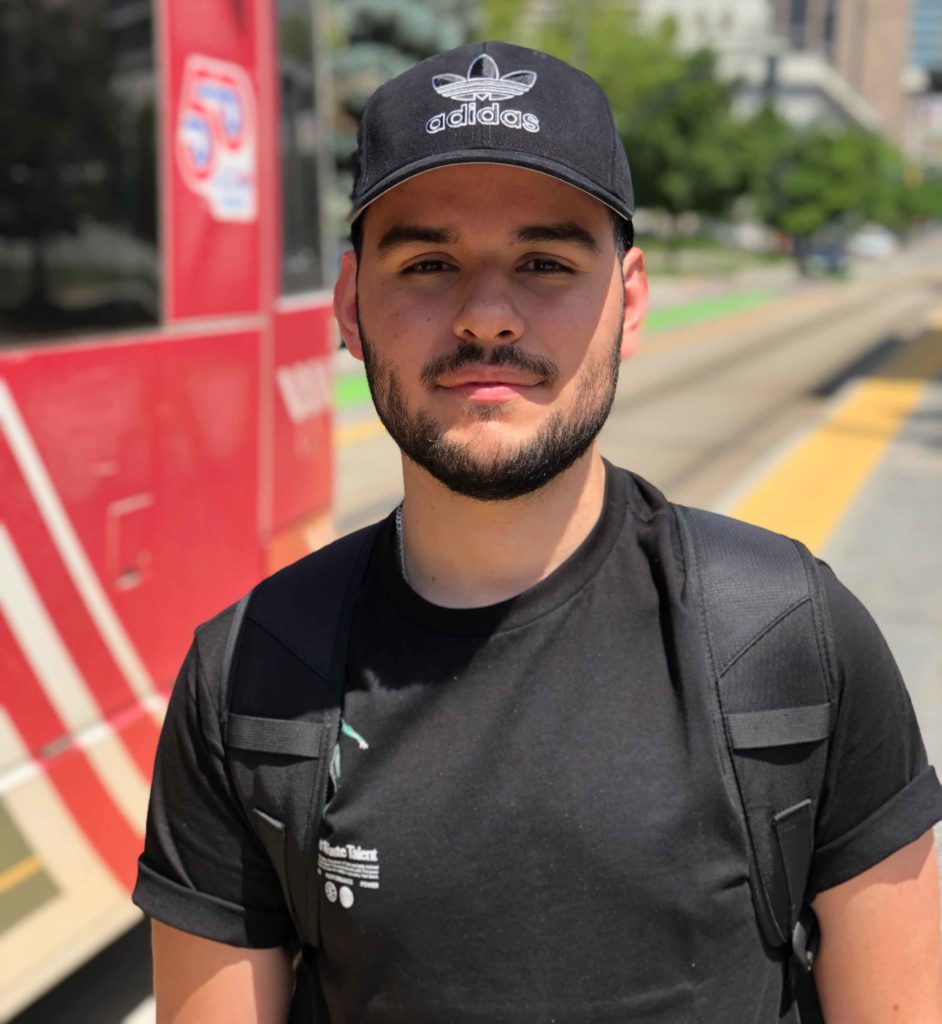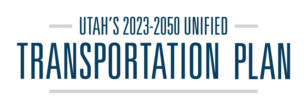Better Mobility
Utah communities come in various sizes, and the ability to move about is a critical concern. Better mobility can be accomplished when travel time is reduced, sharing trips is increased, and reliability of the system is improved.
Drive Time Impacts
By implementing the Unified Plan, the average Utah household will spend fewer days driving each year. Reduced time spent driving is attributed to how the plan improves mobility with high efficiency road and transit projects and how it coordinates these transportation improvements closely with the land use surrounding them.

Active Transportation
Active Transportation, like walking and biking, has great potential to serve not only those desiring a more active lifestyle, but also those who cannot drive or do not have access to a vehicle. The young, the elderly, and lower-income residents whose transportation costs are quite high in relation to income can especially benefit from Active Transportation options.
According to the Council on Active Transportation of the American Association of State Highway Transportation Officials, Active Transportation (or AT) is using human-powered means of travel, which includes walking, bicycling, and the use of mobility aids; and may also incorporate other human-scale modes like electric-powered, electric-assisted, or micro-mobility devices such as e-bikes and e-scooters.
AT is occupying a more useful and attractive space in our transportation system. Leaders and residents throughout Utah have embraced AT as integral to improving air quality, reducing congestion, lowering travel costs, and improving health and the quality of life for individuals and communities. Great strides have been made to improve access and safety for pedestrians and bicyclists, especially with the creation of the statewide Utah Trail Network.
In fact, between now and 2050, Utah will add 4,700 active transportation miles, roughly equal to the distance between Salt Lake City and London. Effective integration of AT with transit and roadways creates a more balanced transportation system for all residents. Better access to employment and recreational opportunities benefits everyone, and no community should be overlooked in this effort.

In October 2022, Governor Spencer Cox and UDOT Executive Director Carlos Braceras announced their vision for a statewide trail network in Utah. The ultimate goal of the network is to build and maintain a network of paved trails throughout the state that connect Utahns of all ages and abilities to their destinations and communities.
During the 2023 legislative session, Utah senators and representatives put their support behind this vision and passed Senate Bill 185, which allocated $90 million to create the state’s Active Transportation Investment Fund (ATIF) for planning, designing, constructing, and maintaining a statewide network of paved pedestrian or non-motorized trails designed to accommodate transportation throughout the state. They also allocated $45 million per year to support this vision into the future.
Meeting the Needs of Our Growing Communities
Transportation needs vary throughout Utah. While some of Utah’s more urban communities have mature transportation systems, others communities are relatively new and growing. It can be a challenge to accommodate the growing transportation demands across the state. While we can’t simply build our way out of congestion, the Unified Plan works to increase highway connectivity, make transit more efficient, provide first-mile/last-mile solutions that connect people to transit, and improve walking and biking facilities to better support transportation choice. This approach caters to the needs of communities throughout the state, whether they are more mature, growing, urban, or rural.
The question of where and how growth unfolds is primarily addressed by local governments as they work with landowners. There is no one-size-fits-all approach. Each community has its own distinct vision for the future. The transportation agencies of the Unified Transportation Plan have coordinated this plan with those local desires for how and where growth unfolds.
A Transportation System for All
Transportation is more than just single-rider vehicle travel. In the future, we must take a more holistic look at transportation as an integrated system. This includes the connection between modes – driving, taking transit, walking, and biking, not to mention connected and autonomous vehicles and drone deliveries – as well as the context around those modes such as land use, economy, housing, wellness, and needs of diverse populations.
Serving All Users
The Unified Plan recognizes a need to provide opportunity for all so that individuals and communities can thrive throughout our region and state. All users, from those who travel by car to those who walk or bike to those with varying physical and economic situations, need to be considered in transportation planning. Expanding transportation options benefits those with limited income by providing better access to opportunities, like jobs, education, healthcare, and more.

The Human Side: Andres
Andres, a native Venezuelan, lives in Taylorsville, attends the University of Utah, and works at Amazon on the weekends. Sometimes it’s not feasible for him to carpool or travel in the family car, so he uses public transit, including TRAX or UTA buses. A typical day for Andres involves connecting by bus to the TRAX Red Line and riding it to the University of Utah for class. On the weekends, Andres takes one of two evening bus routes to get to his job. After his overnight shift, he catches another bus to travel home.
Andres’s schedule is very demanding, but he says it’s worth it to achieve his goals. He looks forward to completing his bachelor’s degree in the next few years and then pursuing a master’s degree in public administration or attending law school. In the meantime, Utah’s transportation system will help Andres get where he needs to go now, so later he can reach his dreams.
The Human Side: Kim
Beginning at age five, Kim struggled with polio, but he never let that slow him down. He rode bikes at a young age and still does. He loves using his handcycle and has participated in a few Bike Tours and Paralympic races. Kim even has a silver medal on display in the U.S. Olympic & Paralympic Museum in Colorado Springs, Colorado.
Kim and his wife retired in St. George in 2016 and have been highly involved in the community ever since. He enjoys recreational cycling on the wide network of trail systems around St. George. As a member of the Southern Utah Bicycle Alliance, Kim collaborates on local active transportation projects and is a big cycling advocate. He looks forward to the addition of more paved trails in the St. George area so he can ride his handcycle everywhere he wants to go.
